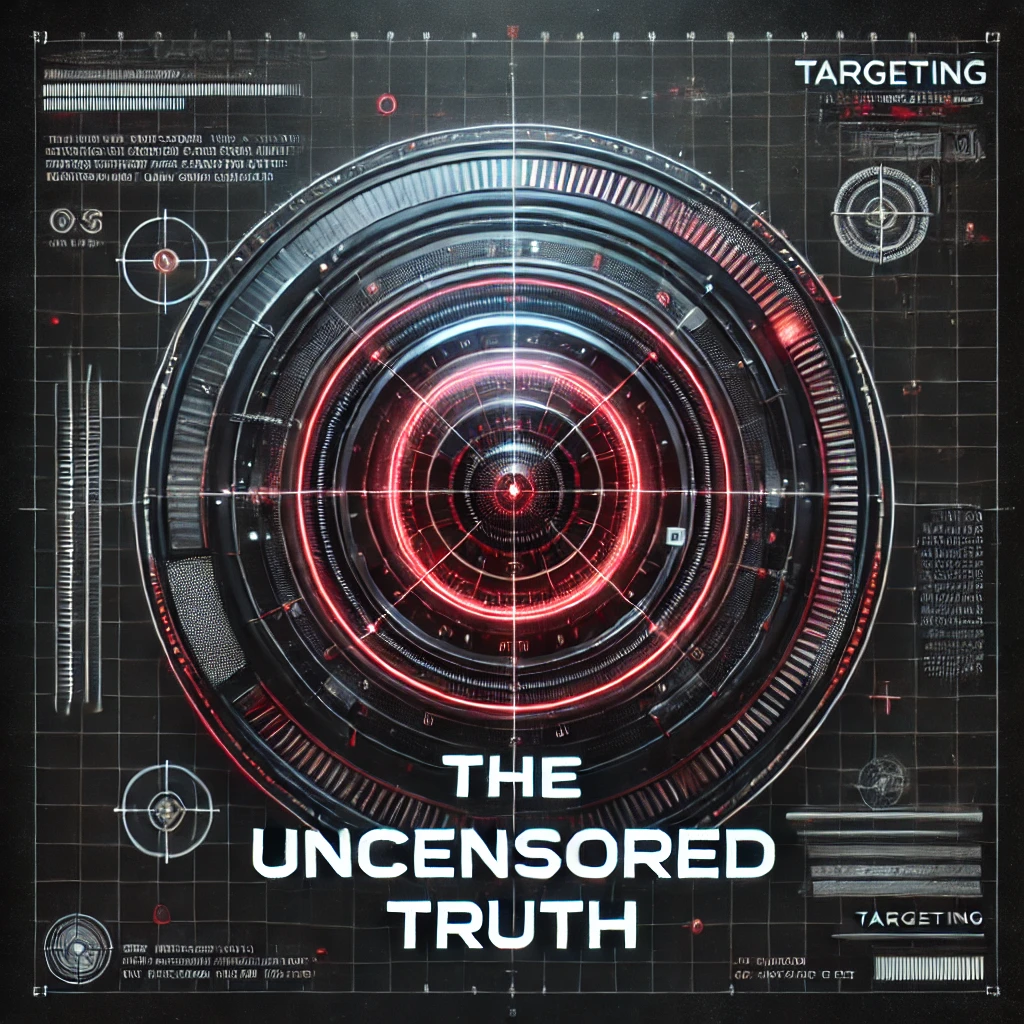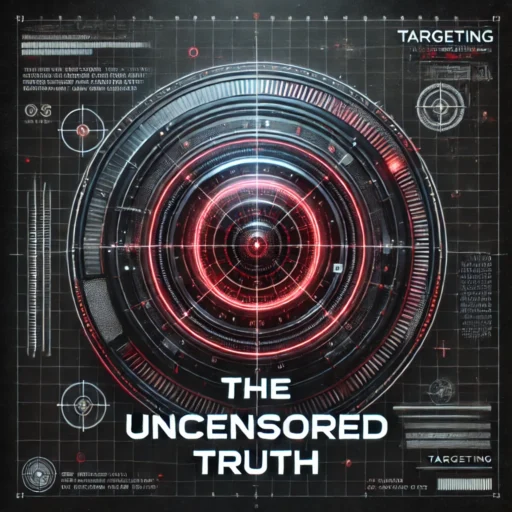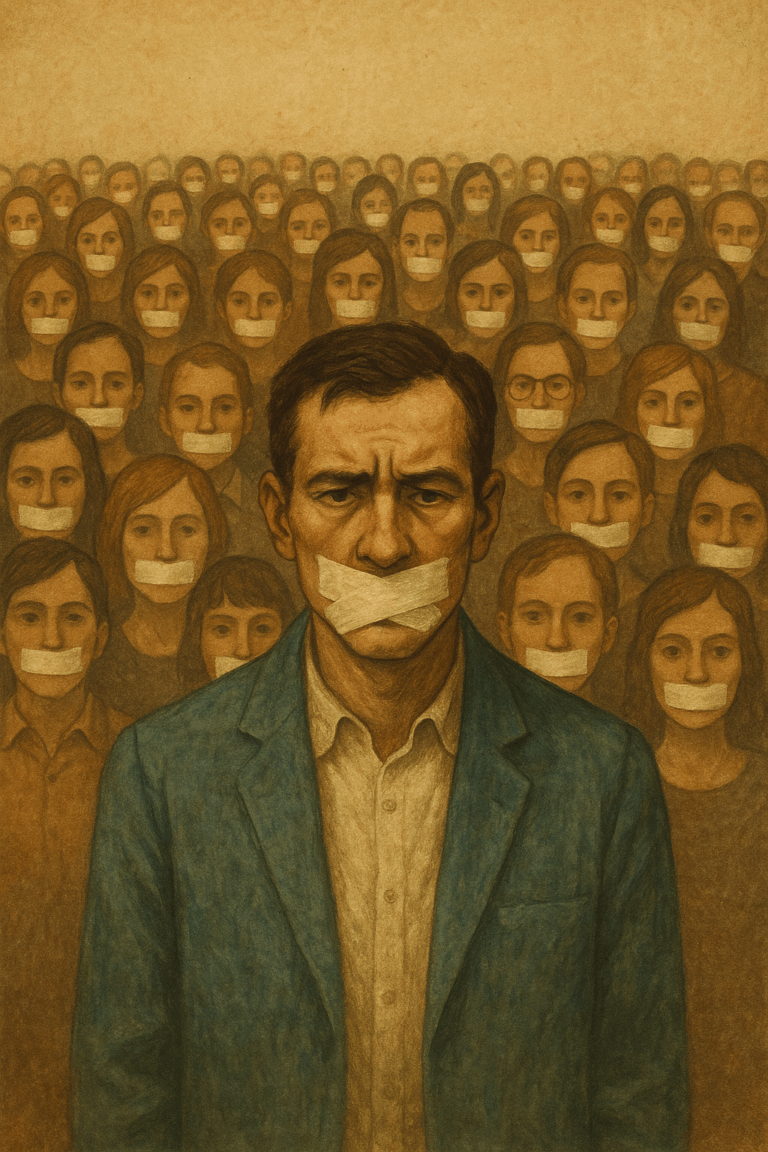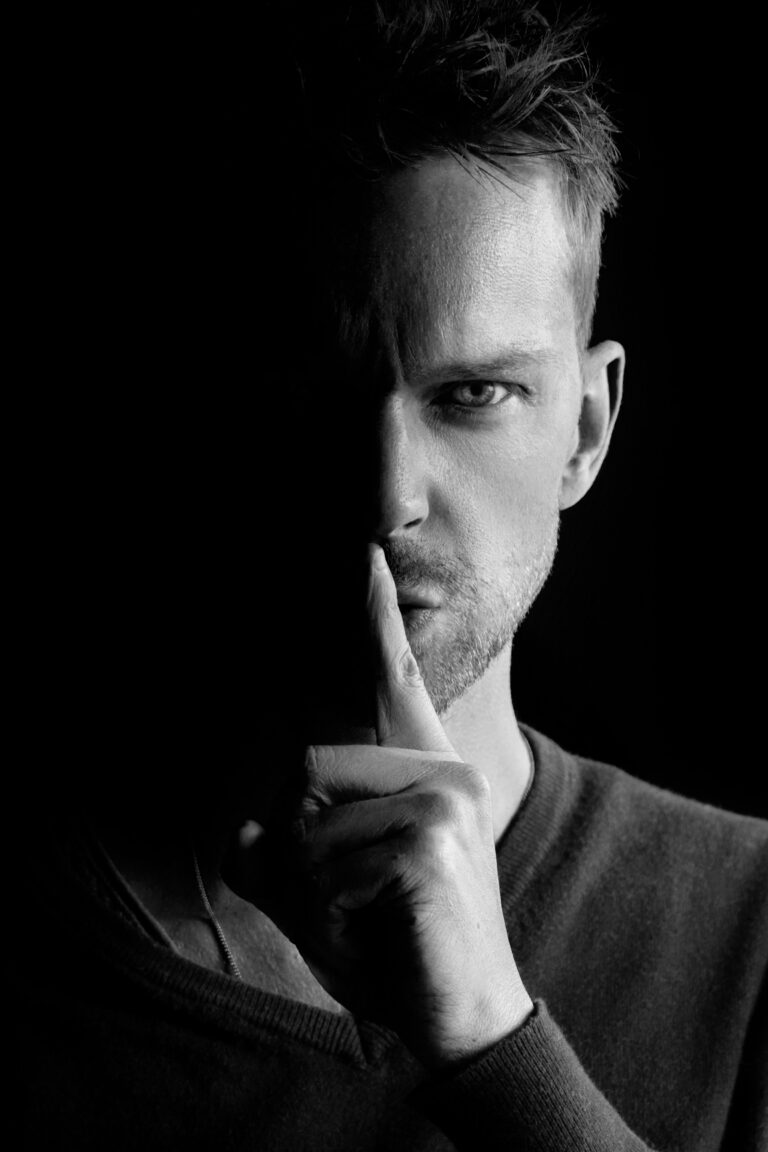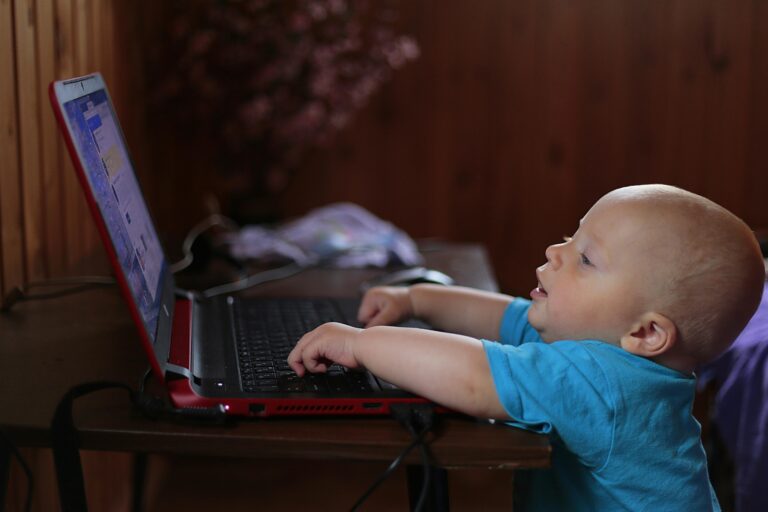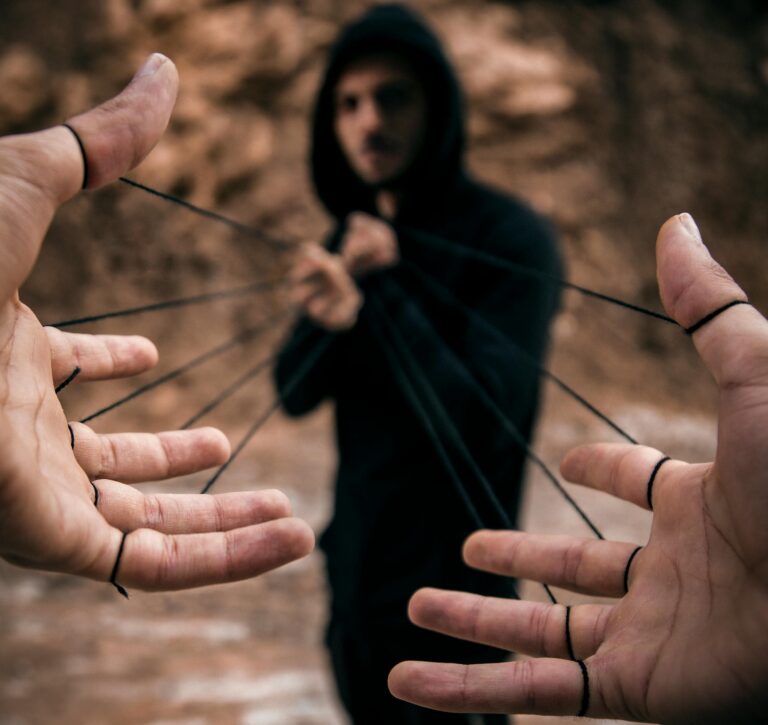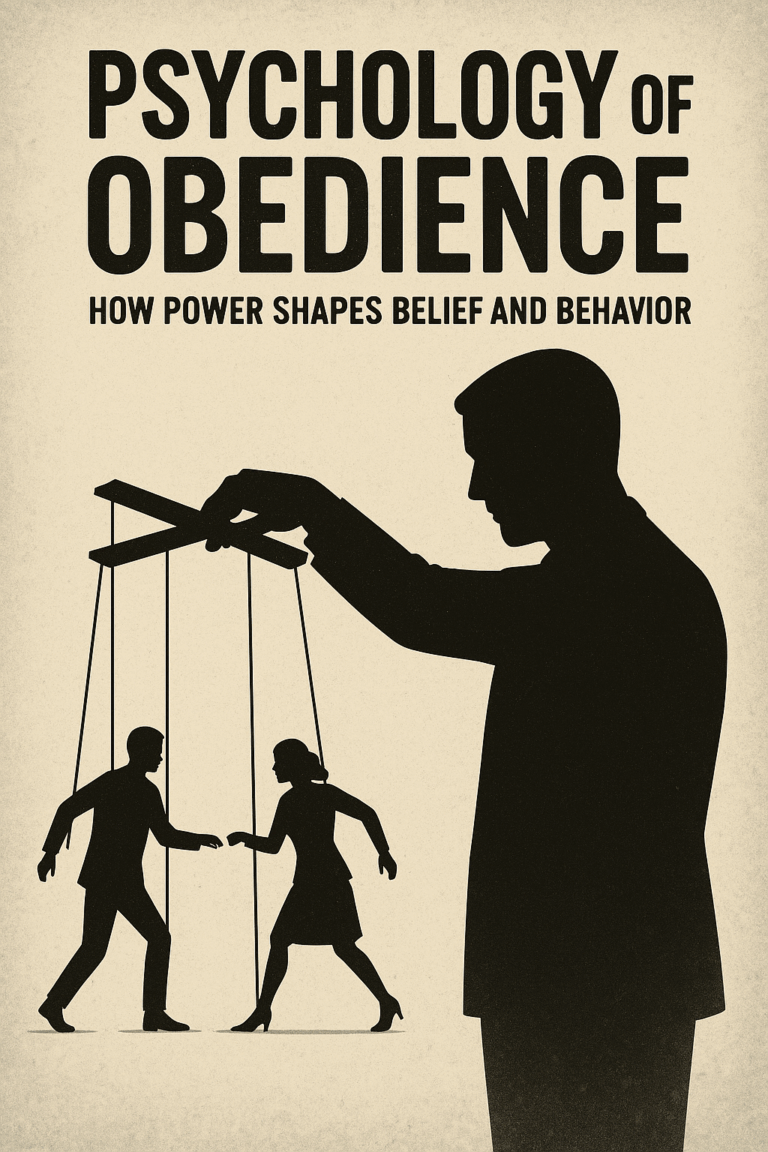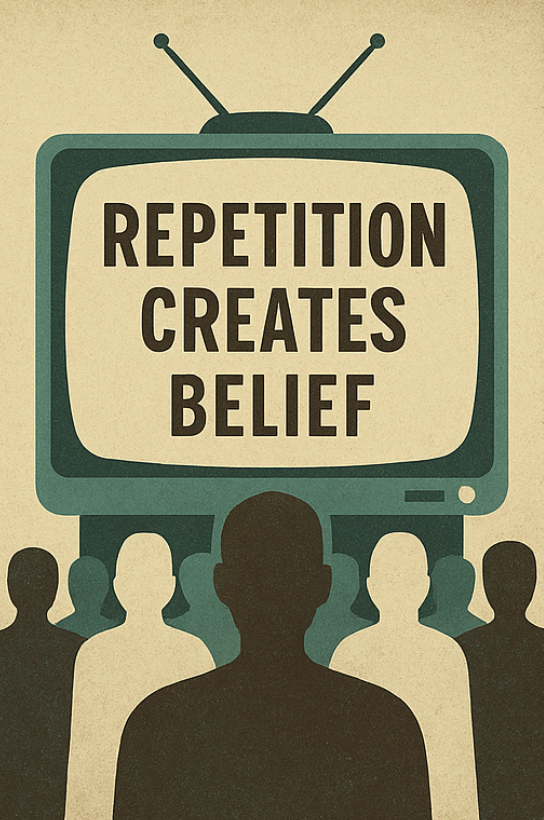Fear and Free Speech: Why It Matters
Free expression is often called the lifeblood of democracy – the mechanism by which ideas are tested and social progress is achieved. Yet fear and free speech have a fraught relationship. Even in societies that legally protect speech, people can be scared into silence. Social backlash, public shaming, or the threat of ostracism often prove as effective as overt censorship in muting dissenting voices. This dynamic isn’t just an abstract concern; it affects everyday conversations and the health of our public discourse. In Part 5 of this Psychology of Control series, we examined how information can be controlled to shape compliance. Here in Part 6, we turn to the psychological climate of fear that leads people to censor themselves, exploring why this issue matters for everyone who values truth and accountability.
When individuals hold back their true opinions due to fear, society as a whole loses. John Stuart Mill warned in On Liberty that the “tyranny of the majority” – the crushing weight of prevailing opinion – can impose a social tyranny more formidable than many kinds of political oppression. In other words, it may not be an official decree that stifles speech, but the glare of disapproval from one’s peers. The result is a chilling effect: controversial but important ideas go unvoiced, errors and misdeeds escape scrutiny, and public compliance with questionable norms grows. Indeed, recent evidence suggests this is a widespread problem – a 2022 national poll found that 84% of Americans believe fear of speaking freely in everyday situations is a serious problem (with over half admitting they’ve “held their tongue” in the past year out of fear of backlash). Such statistics underscore why examining the link between fear and free speech is so important: when silence prevails, democracy and innovation suffer.
Fear and Free Speech: The Psychological Cost of Dissent
What actually happens inside a person who dissents versus one who stays silent? The decision to speak up (or not) often hinges on powerful social emotions – particularly guilt and shame. Though these terms are sometimes used interchangeably, guilt and shame are distinct, and each plays a unique role in enforcing compliance or silence. Guilt is an internal judgement: the feeling that you’ve done something wrong according to your own values. Shame, by contrast, is the feeling of being judged negatively by others – a fear of humiliation or ostracism in the eyes of society. In practice, guilt makes us police our own behavior, while shame makes us fear others’ policing of our behavior. Both emotions can keep people “in line,” but shame is especially potent in silencing dissent. A person may feel guilty for lying or not speaking the truth, but that private remorse can be outweighed by the anticipated shame of being attacked or ridiculed for voicing an unpopular opinion.
Psychologists note that human beings are deeply social creatures, wired to seek acceptance and avoid exclusion. Being socially rejected or cast out of the group isn’t just metaphorically painful – studies show it triggers the same brain regions as physical pain. Even brief episodes of ostracism induce a “social agony” that the brain registers as physical pain, as one neuroscience article put it. This helps explain why standing alone against a crowd can be so psychologically taxing. The cost of dissent isn’t merely the risk of being factually wrong; it’s the visceral sting of isolation or public shaming. When someone considers challenging a prevailing view – whether it’s a student questioning a teacher, an employee criticizing a company policy, or a citizen criticizing government actions – they must subconsciously weigh this emotional cost. Will I be laughed at, shouted down, or cast out of my community? Often, that fear of shame outweighs the individual’s sense of duty or conviction, leading to self-censorship.
Moreover, authorities and peer groups can actively exploit these emotions to enforce compliance. For instance, an organization might foster a guilt complex by telling members that dissenting will “harm the team” or betray shared values. Simultaneously, they may wield shame by publicly labeling dissenters as selfish, disloyal, or morally suspect. This double-pronged psychological pressure convinces many would-be dissenters that speaking up is not worth the personal toll. Classic social psychology experiments demonstrate how easily people’s voices can be subdued by group pressure. In one famous study on bystander behavior, individuals sat in a room that slowly began filling with smoke. When alone, most people quickly reported the danger. But when placed with confederates who acted unconcerned, the majority of participants stayed silent about the smoke, often until it became overwhelming. They doubted their own eyes and remained quiet, apparently out of fear of looking foolish or alarmist in front of others. This is a vivid illustration of the psychological cost of dissent: the internal conflict between what we perceive and what we fear others expect. Time and again, our social brains incline us to err on the side of silence if speaking up carries a risk of embarrassment or exclusion.
The toll on those few who do break the silence can be severe. Whistleblowers who expose corruption, or dissidents who defy authoritarian norms, frequently describe intense anxiety, alienation from colleagues or friends, and retaliation that can upend their lives. Even in free societies, a person who voices a heterodox opinion might be swarmed by online abuse or socially shunned. This is not a sign of individual weakness; it reflects how high the social stakes of dissent are. Small wonder that many people convince themselves it’s virtuous or prudent to keep quiet. In a very real sense, fear – of conflict, of shame, of losing one’s community – becomes a muzzle on the human tongue, and compliance becomes the path of least psychological resistance. The emotional calculus behind silence reveals just how entangled fear and free speech have become in our inner lives.
It is worth noting, however, that not all social pressure is malicious. Sometimes people choose silence out of empathy or politeness, not fear – for example, refraining from harsh criticism to avoid hurting someone’s feelings. But the focus here is on the intersection of fear and free speech – silence motivated by anxiety and coercion, which can be far more pervasive and insidious.
Fear and Free Speech in Historical Perspective
Throughout history, periods of intense fear have often coincided with harsh suppression of dissenting speech. When societies feel under threat, whether from external enemies or internal subversion, the voice of dissent easily gets framed as dangerous disloyalty. Looking back, we find numerous case studies in which fear was consciously or unconsciously used to mute criticism and enforce conformity.
One of the earliest examples in American history occurred in 1798, with the passage of the Alien and Sedition Acts. The young United States was quasi-at-war with France at the time, and Federalist leaders (including President John Adams) feared French spies and domestic traitors in their midst. In this climate of alarm, the Sedition Act made it a crime to publish “false, scandalous, and malicious” criticism of the government. Under this law, printers and opposition politicians were fined or jailed simply for voicing dissent. The intended effect was clear: scare potential critics into silence by threatening them with legal punishment. And it largely worked – open criticism of the Adams administration waned under the pall of possible sedition charges. Thomas Jefferson and James Madison, among others, denounced the Sedition Act as a flagrant violation of free expression. Madison wrote that it “ought to produce universal alarm, because it is leveled against that right of freely examining public characters and measures, which has ever been deemed the only effectual guardian of every other right.” Indeed, in hindsight, history has judged the 1798 Sedition Act as one of America’s sorriest episodes of speech suppression – a fearful overreaction that betrayed the First Amendment. The law expired in 1801 and was never revived, and even the Supreme Court later noted that the Sedition Act had been invalidated in the “court of history.” The lesson: panic over national security had, albeit temporarily, trumped the young republic’s commitment to robust debate. This moment foreshadowed a recurring struggle between fear and free speech in American history.
Fast forward to World War I, and a similar pattern emerged. As the U.S. entered the war in 1917, the government again feared internal dissent – this time from pacifists, socialists, and recent immigrants who opposed the war or the draft. President Woodrow Wilson urged and signed the Espionage Act of 1917 and the Sedition Act of 1918, which together criminalized a broad swath of anti-war speech. It became punishable by law to utter or publish anything that could be seen as disloyal or critical of the government’s war effort. The wording was so broad that simple free expression was enough to land a person in prison if their views were unpopular. And many were indeed prosecuted – over 2,000 Americans were charged under these laws, including prominent figures like labor leader Eugene V. Debs, who was sentenced to ten years in prison just for delivering an anti-war speech. The fear driving this crackdown was that dissent would sap national unity and aid the enemy. In the fever of wartime, opposition voices were painted as subversive threats rather than fellow citizens with differing beliefs. The U.S. Supreme Court initially upheld these convictions, with Justice Oliver Wendell Holmes infamously comparing anti-war speech to “shouting fire in a crowded theater” – coining the “clear and present danger” doctrine that justified curtailing speech under extreme circumstances. Only later, after the war’s passions cooled, did Holmes and other justices begin to change course toward stronger First Amendment protections. Looking back now, those WWI sedition prosecutions are widely condemned as violations of civil liberty spurred by wartime hysteria. Once again, fear had induced a moral panic that equated dissent with disloyalty, to the detriment of core democratic principles.
Perhaps the most notorious example of fear silencing speech in U.S. history is the era of McCarthyism in the late 1940s and 1950s. During this “Second Red Scare,” Americans were gripped by the fear of communist infiltration amid the Cold War. Senator Joseph McCarthy and others capitalized on this atmosphere, launching aggressive investigations and public accusations against supposed communists in government, Hollywood, universities, and beyond. Crucially, McCarthyism did not generally outlaw speech by statute; instead, it relied on social pressure, blacklists, and reputation destruction to enforce conformity. The mere accusation of being a communist sympathizer was enough to ruin careers and turn friends against you. As a result, few dared to voice any criticism of U.S. policies or to defend those targeted, for fear of themselves being labeled traitors. Libraries pulled controversial books; professors avoided discussing Marx; entertainers hid any past leftist associations. Supreme Court Justice William O. Douglas later described the effect of this period as “the black silence of fear.” It was as if a blanket of anxiety had fallen over public discourse, narrowing the spectrum of acceptable ideas and suppressing most serious criticism of government policy during the early Cold War. Even after Senator McCarthy was eventually discredited and censured, the timidity that McCarthyism instilled in public life lingered. People had learned that speaking too freely, even in a so-called free country, could carry devastating consequences when the social mood was ruled by fear. It took a concerted cultural effort – and the passage of time – to recover a sense of security in expressing unpopular views again.
These historical cases – the Alien & Sedition Acts, the WWI sedition prosecutions, McCarthyism’s chill – illustrate a common pattern. In each, authorities invoked fear of some grave threat (be it foreign agents, wartime enemies, or ideological subversives) and argued that unity was paramount. Dissenting voices were cast as harmful to public safety or morale, justifying extraordinary measures to silence them. Society, gripped by fear, often acquiesced or even supported the suppression of free speech during these crises. Only later, with the benefit of hindsight, did the public usually recognize the overreach and harm that had been done. It’s a sobering reminder that fear can dramatically shift the balance between freedom and control. The true test of a society’s commitment to free speech often comes not in calm times when everyone agrees, but in moments of crisis and dread – moments when the temptation to stifle dissent in the name of security or solidarity is at its highest.
Mass Hysteria and the Weaponisation of Fear
Fear is not only an individual emotion; it can spread through groups like wildfire. Social psychologists speak of “fear contagion” – the way one person’s panic can infect others, amplifying into collective hysteria. When entire communities succumb to fear, critical thinking tends to evaporate and people may accept drastic measures that they would normally reject. This phenomenon, sometimes called mass formation or mass hysteria, has appeared across cultures and eras. It’s evident in episodes like the Salem witch trials of the 1690s (where fear of witches led to baseless accusations and executions), or the various “moral panics” that have gripped societies (for example, the Satanic Panic of the 1980s, when unfounded fears of satanic cults spread across the U.S., ruining many lives with false accusations). In such cases, fear itself becomes a social force – a tool that can be weaponized by those who know how to manipulate it.
Mass hysteria is often characterized by a clear in-group vs. out-group dynamic: the frightened majority bonds more tightly together, while dissenters or scapegoated minorities are singled out as targets of blame. Psychologist Gustave Le Bon observed over a century ago that crowds under the sway of a strong emotion behave almost like a different creature – prone to irrational, unified action. In a state of mass fear, people may relinquish their individuality and independent judgment (“submergence,” as Le Bon called it) and follow the emotional current of the crowd. Ideas and emotions become contagious: if everyone around me is signaling that a certain person or idea is terrifying, I too feel that fear and join the chorus, even without concrete evidence. This contagious fear creates a feedback loop – any voice trying to counter the panic sounds suspect or traitorous, which in turn heightens the crowd’s conviction that they must be right to fear. Thus, the crowd readily silences or even attacks those who question the prevailing fear-driven narrative.
History provides stark examples of leaders intentionally weaponizing fear to control the masses. Authoritarian regimes are past masters at this. They rally the public around real or manufactured threats – spies, saboteurs, impure elements – then label anyone who disagrees as part of the threat. Nazi Germany’s propaganda chief famously asserted that you can lead a people anywhere if you convince them they are under attack and that dissenters are disloyal. Hermann Göring, a top Nazi official, put it bluntly during the Nuremberg trials: “The people can always be brought to the bidding of the leaders. That is easy. All you have to do is tell them they are being attacked and denounce the pacifists for lack of patriotism and exposing the country to danger.” In other words, scare people badly enough and they will not only tolerate but demand the silencing of those who speak against the rush to war or persecution. Under such mass formations, fear becomes a political weapon – a means to forge consensus by marginalizing dissent. It creates a social atmosphere where many citizens actually participate in policing each other’s speech, believing they are defending society from dangerous elements. Dissenters, meanwhile, are painted as either crazy (in a mass hysteria, their calmness seems delusional) or malicious. This dynamic was evident in McCarthyism, as we saw, and recurs in various forms whenever societies work themselves into a frenzy over an issue.
Even in more open societies, smaller-scale moral panics show similar mechanisms. Consider how a sensational news story can spur public fear and calls for censorship. For instance, a single dramatic crime might ignite a media-fueled panic about a genre of music, a video game, or a minority group “inciting violence,” leading to social vilification of that group and pressure to silence their expression. Sociologists who study moral panics note that they often involve “folk devils” – scapegoats blamed for complex problems – and “moral entrepreneurs” – people (often in media or politics) who stoke public fear to push an agenda. In these episodes, fear spreads quickly and nuance collapses. Gray areas disappear; one is either on the side of safety or cast among the devils. In such an emotionally charged environment, few dare voice a dissenting opinion that questions the panic. It’s in these moments that fear and free speech find themselves locked in direct conflict, with fear usually gaining the upper hand. The majority’s fear-driven narrative effectively drowns out debate.
Modern technology can accelerate fear contagion in unprecedented ways. Social media platforms, for example, can amplify panic and outrage within hours, creating digital mobs that mete out judgment without evidence. A false or exaggerated claim can “go viral” and create mass hysteria online, with real reputational or even legal consequences for those targeted. We’ve seen cases of individuals being globally shamed and silenced overnight because a fearful narrative took hold on the internet (sometimes later proven untrue, but only after the damage was done). Fear and free speech are thus increasingly mediated by algorithms that favor emotionally charged content. The weaponization of fear in public discourse now often involves trending hashtags and viral memes that rally people into an emotional swarm, ready to attack deviants from the consensus.
Crucially, mass fear need not be deliberately engineered to have the same silencing effect. Natural disasters, pandemics, and other crises can organically generate widespread fear that narrows public tolerance for dissent. A recent example is the COVID-19 pandemic. As anxiety about the virus’s threat grew, many societies saw a dramatic hardening of attitudes toward anyone who questioned official health policies or dominant viewpoints about the crisis. Even well-intentioned debate about the balance between public safety and personal liberties became emotionally charged. Some scholars, like Belgian professor Mattias Desmet, have argued that elements of “mass formation” occurred – a kind of group hypnosis where a single narrative took hold and those who dissented (even other experts or scientists) were aggressively censured or dismissed. Whether or not one agrees fully with that assessment, it’s clear that fear can create a climate where dissent is equated with endangering others, and thus silence is seen as the only responsible option. On the flip side, fear can also be cynically invoked by interest groups to discredit any dissenting voices (“If you listen to those people, it will cost lives!”), shutting down dialogue. The pandemic context showed both the genuine need for social unity in a crisis and the dangers when fear shuts out nuanced discussion. The challenge is finding a way to manage collective threats without succumbing to collective hysteria.
In sum, mass hysteria and the weaponisation of fear demonstrate how powerful and contagious fear can be in shaping what speech is allowed. A frightened group tends to policing its own members far more ruthlessly than any censor could. For those concerned with free speech, this underscores that defending open discourse isn’t just about laws – it’s about culture and psychology. We must be vigilant that fear, however justified it may seem, does not become an excuse to trample the voices of the minority or the dissenter. Because once a society normalizes that pattern, it lays the groundwork for future abuses of power and the erosion of truth. History’s witch hunts, sedition trials, and Red Scares all reveal the same moral: truth and progress often emerge from the very voices fear tries to silence. Understanding mass fear dynamics is key to resisting them. After all, fear spreads fast – but courage can be quietly contagious too, if even a small minority remain willing to speak when it matters.
Fear and Free Speech in Modern Democracies
One might assume that in modern democratic nations – with strong constitutions, free press, and open courts – fear would no longer silence free speech. To an extent, explicit censorship is indeed rarer in democracies than in authoritarian states. Yet even in free societies, fear and social pressure can mute dissent just as effectively through informal means. In fact, contemporary democracies present a paradox: they legally protect speech, but large numbers of people voluntarily self-censor due to social fears. This phenomenon is evident in various surveys and social studies. For example, a recent academic study found that roughly 40% of Americans have kept their opinions to themselves out of fear of social consequences, a figure that has grown with rising political polarization Washington University study on self-censorship. In other words, nearly half the populace in a free country isn’t taking full advantage of that freedom, because the personal cost of speaking freely has become too high in their eyes.
What drives this self-censorship? In modern democracies, people fear different kinds of backlash depending on the context. In some circles, the fear might be of being labeled bigoted or insensitive if one voices an unpopular opinion on social issues. In other circles, the fear might be of being labeled unpatriotic or disloyal if one criticizes national policy or questions a prevailing patriotic narrative. The common thread is that speaking out can bring swift social sanctions – not jail time, but public shaming, career consequences, or ostracism. With the advent of the internet and “cancel culture” dynamics, these consequences can feel especially immediate. A single tweet or comment can unleash thousands of strangers to pile on criticism, or it can be screenshot and circulated to your employer or community. The result is a pervasive “chilling effect”: people preemptively bite their tongues on contentious topics, whether around the dinner table, in the classroom, or on social media. Even in democratic nations, fear and free speech continue to collide where digital risk and public scrutiny converge.
Importantly, this phenomenon spans the political spectrum. Progressives on a college campus might fear speaking up if their viewpoint is seen as not sufficiently progressive, just as a conservative in a small town might fear social exile for questioning a patriotic consensus. The content of what is considered “unsayable” may differ by community, but the mechanism of silencing – social intimidation – is very much the same. College students report that they sometimes hold back on discussing certain issues in class because they worry a poorly phrased comment could lead to public vilification or administrative discipline. Employees in workplaces may avoid voicing concerns or innovative ideas if those go against the company culture, fearing subtle retaliation or loss of opportunities. Even within families, people tiptoe around certain subjects to avoid being castigated or causing a rift. The psychology of fear operates at all these levels, meaning free speech can be curtailed not just by government, but by peer-to-peer pressure and cultural norms.
Modern democracies also grapple with formal measures that can instill fear around speech. For instance, many countries enforce laws against “hate speech” or disinformation with the intent of protecting society from harm. While such laws often come from good intentions, they can inadvertently create a fear of stepping over ill-defined lines. If the boundaries of permissible speech are blurry, individuals may over-correct and avoid any statement that might be construed as offensive or false, even if it’s made in good faith. The result can be a subtle self-policing where citizens only feel safe echoing majority-approved ideas. For example, in some European democracies, robust laws exist against Holocaust denial and extreme hate propaganda – which most agree is justified – but debates continue about whether expanding such laws to cover less clear-cut “hate” or “misinformation” might chill legitimate debate on sensitive issues. When does protecting social harmony begin to infringe on the “freedom to disagree” that is vital in a democracy? That question is actively negotiated in many societies today. Responsible citizens may fear running afoul of evolving speech norms or regulations, and thus they err on the side of silence or excessive caution.
Social media companies and their content moderation policies add another layer. Users know that posting certain viewpoints might get them “flagged” or banned, or unleash a torrent of online harassment. For instance, during heated political moments (e.g. elections, referendums, public health crises), many people refrain from sharing their honest opinions online because they fear a digital mob or simply don’t want to risk their accounts being suspended. In theory, these platforms are a democratizing space for free expression; in practice, they can become arenas of such acrimony that many retreat into private, like-minded groups, abandoning the broader public conversation.
Ironically, fear in democracies often persists not because of an oppressive government, but because of ourselves – the social judgments we cast and the tribal loyalties we enforce. Alexis de Tocqueville observed in the 1830s that in America, public opinion can form a majority tyranny more suppressive than any law. Today’s hyper-connected society has intensified that phenomenon. A democratic government might uphold free speech, yet the democratic society informally punishes it through what Tocqueville called “the tyranny of the majority.” Thus the battleground for free speech in modern democracies is often cultural. Do we, as citizens, truly practice tolerance for dissenting views? Or do we, perhaps subconsciously, use shame and exclusion to keep everyone in ideological lockstep?
Encouragingly, awareness of this issue is growing. Many people across the political divide have begun to recognize the dangers of a society where everyone is frightened to speak their mind. Initiatives on campuses seek to promote viewpoint diversity and teach students how to debate civilly rather than cancel each other. Legal scholars argue for clearer protections for speech in the workplace and public square to reduce the fear of sudden social punishment. Even within social movements, there are calls to temper the impulse of dogmatism and embrace a bit more empathy for those who dissent or err. After all, a democracy depends on an uninhibited “marketplace of ideas” – a concept famously articulated by Justice Louis Brandeis – where the remedy for bad or offensive speech is more speech and open rebuttal, not enforced silence. To maintain that ideal in a climate of fear, deliberate effort is needed.
Alexander Meiklejohn, a 20th-century philosopher of free expression, argued that the purpose of free speech is self-government – a society cannot govern itself wisely if certain views are afraid to surface. He insisted that democracy will not function if leaders or majorities can stifle discussion, and that the First Amendment’s core meaning is that “the freedom of ideas shall not be abridged.” In practice, that means a democracy must cultivate a culture where people feel secure to voice unpopular truths or challenge prevailing assumptions. If fear takes that security away, the society risks making bad collective decisions because dissenting facts or perspectives were never heard. One clear contemporary example: in the lead-up to the 2003 Iraq War in the United States, there was tremendous social and political pressure to show unity and patriotism. Those who questioned the evidence for weapons of mass destruction or the rush to war were widely denounced as unpatriotic at the time. Only much later did it become clear that more critical debate might have led to better decision-making. It’s a reminder that conformity born of fear can carry steep costs, even in a country that values free debate.
The health of free speech in modern democracies, then, isn’t guaranteed by statutes alone. It relies on the courage of individuals and the tolerance of society at large. Each of us contributes to the climate of discourse. Do we encourage honest dialogue, even when it’s uncomfortable, or do we pounce on those who stray from orthodoxy? Do our institutions – media, universities, companies – foster an environment where whistleblowers and iconoclasts are respected participants, or do they instill fear that stepping out of line will be career suicide? Answering these questions honestly is crucial. The evidence suggests many democracies are at a crossroads: citizens are wary of speaking freely, yet they also recognize that a culture of silence and self-censorship is unhealthy. Navigating away from this predicament will require conscious effort to reaffirm the social value of dissent. After all, the true strength of a democracy is measured not by how loudly the majority can cheer, but by how safely the minority can disagree.
When Silence Becomes Virtue
In a climate of sustained social pressure, a curious moral inversion can occur: silence itself gets reframed as a virtue. What does this mean? It means that keeping quiet, not making waves, and not questioning the consensus starts to be seen not as cowardice, but as good citizenship. The silenced majority tells itself that it is doing the right thing by staying quiet. Meanwhile, the few who still speak up are cast as troublemakers, aggressors, or egotists “stirring the pot.” This section explores how societies come to view silence as a positive value – even a moral duty – and how that reinforces the cycle of fear and suppression.
One common way that silence is valorized is through appeals to social harmony and cohesion. Leaders or peer groups may argue that unity is so important that voicing disagreements or inconvenient truths is harmful. For example, during times of war or national crisis, the mantra “Don’t rock the boat” often prevails. Citizens are told that openly criticizing the leadership or strategy would only aid the enemy or demoralize the nation. In these scenarios, holding one’s tongue is portrayed as an act of loyalty and solidarity. We see historical echoes of this in slogans like “Loose lips sink ships” from World War II, which warned people that speaking out could be dangerous. The message is clear: virtue lies in silence; vice lies in dissent. Similarly, in organizations – whether it’s a corporation or a religious institution – members might be taught that airing internal problems publicly is a betrayal. Whispered admonishments of “for the good of the community, keep this to yourself” encourage individuals to suppress criticism in the name of collective virtue. Over time, this can create a culture where silence about wrongdoing or disagreements is equated with being a “team player” or a loyal member of the group.
Cultural and religious norms sometimes explicitly elevate silence to a virtue. Phrases like “If you don’t have anything nice to say, don’t say anything at all” or “Children should be seen and not heard” inculcate the idea from an early age that keeping quiet is a sign of maturity and goodness. In many traditional societies, deference to elders and authority is taught as a high virtue – which often practically translates into not contradicting or challenging those above you. These norms reinforce the subtle message that fear and free speech are incompatible — that speaking up threatens social harmony. In these contexts, someone who remains silent in the face of a dubious decree might actually be praised as humble and obedient, whereas someone who objects (even rightly) could be criticized as arrogant or unruly. This is not to say that respect and restraint have no place, but when taken to an extreme, they create a moral framework in which dissent = bad, compliance (or at least outward compliance) = good. The result is that people internalize a sense that virtue is demonstrated by silence. They might even feel guilty if they consider speaking up, as if by doing so they would be committing a moral transgression against the community’s harmony.
Modern “cancel culture” debates also illustrate the phenomenon of silence as virtue from another angle. In some activist circles, there is a strong emphasis on calling out speech that is seen as harmful – racism, sexism, etc. This has undoubtedly raised awareness of important issues. But it has also, at times, led to an implicit suggestion that “good” people will refrain from discussing certain topics or will quickly apologize and retreat if challenged, whereas “bad” or insensitive people insist on speaking freely regardless of others’ feelings. Thus, a social virtue is made of self-silencing for the sake of others’ comfort. While courtesy and empathy are virtues, if taken too far this norm can discourage honest discourse on complex issues. Individuals who have questions or alternative perspectives may decide that the morally right thing to do is simply remain silent, so as not to cause offense or be branded -ist or -phobic. In effect, the avoidance of conflict is seen as moral high ground. That can foster a shallow appearance of consensus (everyone seems to agree, because the dissenters say nothing), which in turn reinforces the idea that only bad people would break the silence. It’s a feedback loop that solidifies silence as the safer, and even nobler, course.
Institutions sometimes explicitly reward silence. Whistleblowers who expose misconduct, for instance, often face career consequences, whereas those who kept the issue quiet may be seen as loyal employees and get promoted. In the public sphere, officials who toe the party line are celebrated as “team players,” while mavericks are marginalized. Social praise and material rewards thus flow to the silent conformists, not the outspoken critics. Over time, this differential treatment teaches everyone which behavior is valued. Silence (or at least publicly visible silence) becomes synonymous with virtue, professionalism, loyalty, and decorum.
There is also the aspect of “virtue signaling” in remaining silent. Paradoxically, one might signal one’s moral virtue by not engaging in debate, especially with those deemed beyond the pale. For instance, some people take pride in saying, “I refuse to dignify that idea with a response,” implying that even arguing against it would give it undeserved legitimacy. In some cases this stance is understandable – we need not debate every fringe theory. However, taken broadly, this attitude can foster an intellectual atmosphere where avoiding dialogue is seen as righteous. The result is hardened echo chambers, where each side of a controversy believes it is virtuous for ignoring or shutting out the other side entirely. They consider themselves morally upright for maintaining silence toward opposing views, rather than engaging or rebutting. Again, silence is equated to purity, whereas engagement (even to disagree) is tainted by association.
This “silence as virtue” mindset is problematic for a few reasons. First, it can mask problems rather than solve them. A classic example is within organizations or governments where a culture of silence about issues (like safety concerns, corruption, or abuse) allows those issues to fester until they explode. The Catholic Church’s long suppression of internal dissent about child abuse by clergy is one tragic illustration: many insiders stayed silent to protect the Church’s reputation (seeing that as the greater good), but ultimately that silence enabled greater harm. Silence, though cast as loyalty, became complicity. Second, enshrining silence discourages the feedback and course-corrections that healthy communities need. If everyone is applauded for nodding along, leaders may never receive the constructive criticism necessary to improve policies or decisions. What is initially portrayed as “keeping the peace” can lead to stagnation or error.
It’s important to note, of course, that not all silence is cowardice, and not all speech is beneficial. Wisdom sometimes lies in knowing when to speak and when to listen. But when silence is imposed by fear or mischaracterized as the highest virtue in situations where moral courage is actually needed, societies get into trouble. Real virtue is not passive. It often requires speaking up for what is right, even when inconvenient. As the writer Cyrille Jeufo remarked in analyzing a recent free speech controversy, too often politicians weaponize “cohesion” to silence dissent, trying to make passionate criticism look like hate and silence as virtue. In truth, authentic social cohesion isn’t achieved by everyone biting their tongue and pretending to agree; it comes from acknowledging differences and addressing them honestly. A society that celebrates silence in the face of questionable norms is likely suppressing truths that need to be told.
Turning the tide requires rethinking our social rewards. We must start valuing thoughtful dissent as an act of civic virtue in its own right. That means praising whistleblowers who expose wrongdoing instead of ostracizing them. It means teaching children not just to be polite, but also that it’s admirable to stand up for someone being treated unfairly or to question falsehoods respectfully. It means ensuring that “going along to get along” is not the highest praise we give to members of a group. Ultimately, it requires recognizing that sometimes silence is not golden – it’s merely gilded cowardice. True virtue may lie in the courage to speak, kindly but firmly, when silence would be easier. Only by dislodging the false halo around silence can we break the cycle where fear perpetuates itself under the guise of good manners or loyalty as suggested in this article on cohesion and dissent.
Fear and Free Speech: A Test of Collective Integrity
We arrive, then, at a central insight: the tension between fear and free speech is ultimately a test of collective integrity. How a society handles dissent in fearful times reveals its true commitment to its values. It’s easy to proclaim support for free expression when there’s no cost or when the opinions being expressed are popular. The real challenge comes when allowing free speech creates discomfort, discord, or perceived risk. Do we uphold the principle even then, or do we rationalize away its suppression? The answer speaks volumes about our integrity as a democratic community.
Integrity, in this context, means adhering to fundamental principles (like freedom of expression and inquiry) even when temptation is high to abandon them. It also means a kind of wholeness or consistency – not becoming fractured by hypocrisy or double standards. A society with integrity doesn’t demand silence from others while reserving loud freedom for itself; it applies the same standards of openness across the board. Maintaining this integrity isn’t easy. Fear will always tug at us to find exceptions: “free speech is important, but not for those people; open debate is good, except now when it’s dangerous.” It requires collective courage to resist those tugs and remember that suppressing voices in panic often causes greater damage long-term.
We can draw hopeful lessons from those moments in history when individuals and societies passed this test. Think of the lonely figures who defended free speech rights in the midst of hysteria – the newspapers that dared to criticize McCarthyism at its peak, or Senator Margaret Chase Smith, who in 1950 confronted McCarthy with her “Declaration of Conscience” and affirmed every American’s right to criticize and hold unpopular beliefs. Or consider Judge Learned Hand’s famous words in 1944, at the height of World War II, that “the spirit of liberty is the spirit which is not too sure it is right” – a reminder that humility and openness define a free people, even when united by fear of an external enemy. Over time, those voices of integrity often prove prescient. Societies eventually regret the witch hunts and gags imposed in panic. No internal or external threat has ever been truly eliminated by silencing honest discussion; on the contrary, that often creates new injustices to reckon with.
In modern times, maintaining collective integrity means fostering a culture that treats freedom of speech not as a partisan weapon or a fair-weather ideal, but as a core civic responsibility. It falls on all of us – leaders, citizens, institutions – to create an environment where people do not have to be heroes to speak their mind. In practical terms, that might involve everything from legal reforms (to protect whistleblowers and limit vague speech restrictions) to education (teaching critical thinking and resilience against crowd psychology), to simply modeling respectful dialogue in our daily interactions. It definitely involves a willingness to listen, even when hearing someone’s dissenting view makes us uncomfortable or angry. If we respond to unwelcome speech with reasoned counterarguments rather than personal attacks, we help dissipate fear on both sides. Each time someone experiences that they can disagree without being exiled or humiliated, it chips away at the culture of fear.
Conversely, every time we choose the easy path of shaming or shutting someone up because it’s expedient, we contribute to the erosion of integrity. This isn’t to say there should be no social consequences for genuinely harmful speech – there is a line when expression turns into harassment or incitement. But that line must be drawn carefully, sparingly, and based on principle, not on momentary passions or popular sentiment. Otherwise, exceptions swallow the rule and fear creeps back in.
We also need to recognize that public harmony and freedom of expression are not enemies, though they’re often framed that way. True public harmony rests on freedom of expression. Superficial calm achieved by universal silence is brittle and false; it can shatter at a spark because underlying grievances or ideas were suppressed, not resolved. By contrast, a community that actively engages differences may have more audible conflict, but it is working through issues and can reach genuine understanding. Striving for a balance, as many thinkers suggest, is key. We want a society where debates are vigorous but also civil – where people can disagree strongly without fear of being cast out or attacked. Achieving that balance is an ongoing project, requiring what one commentator called “open-mindedness, nuance, and care for all affected communities” in navigating free speech issues. In other words, it requires integrity: the honesty to permit dissent, and the empathy to do so in a way that doesn’t needlessly alienate.
In conclusion, the dance between fear and free speech will likely never end. It is part of the human condition that we seek safety in consensus and feel anxiety at conflict. But our collective maturity is measured by how we manage that instinct. Will we allow fear – whether of pandemics, ideological opponents, or social disapproval – to choke off the open exchange of ideas that propels us forward? Or will we uphold the courage of our convictions, trusting that more speech and understanding, not enforced silence, is the way to public harmony in the long run? This is the ongoing tension at the heart of every free society. It is not a problem to be “solved” once and for all, but rather a balance to be continuously maintained through wisdom and good faith.
Ultimately, meeting this test comes down to each of us. It’s in the little moments: choosing not to dog-pile on someone for an unpopular view, or gently challenging a commonly accepted falsehood rather than letting it slide; supporting a friend who voices a dissenting opinion instead of nervously distancing from them; reminding others (and ourselves) that disagreement does not equal bad intent. These small acts build a resilient culture where fear doesn’t rule and speech doesn’t have to be smothered for the sake of appearances. A society with such integrity can face even the most frightening challenges without losing its voice or its soul. Our response to the tension between fear and free speech will shape the strength and character of our civic future. Real public harmony is not the absence of noise – it’s a chorus of different voices, finding common ground through honest expression. But how do we balance free speech and social harmony? Each time we refuse to let fear dictate who gets heard, we affirm that harmony and free speech can coexist, and we inch closer to the ideal of a truly free and open community. That is the ongoing work and the promise of democratic life, a journey we must walk together with both courage and compassion.
